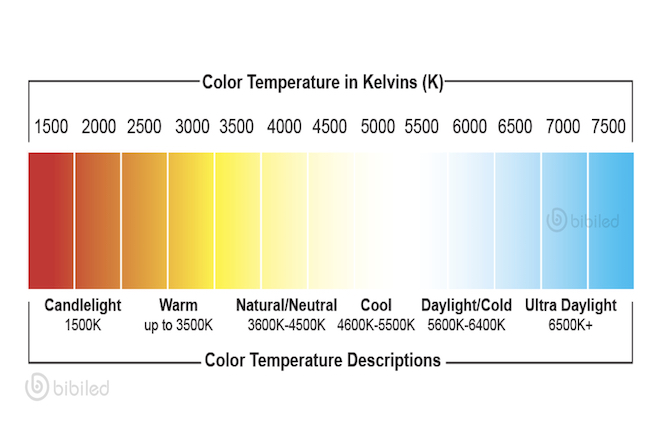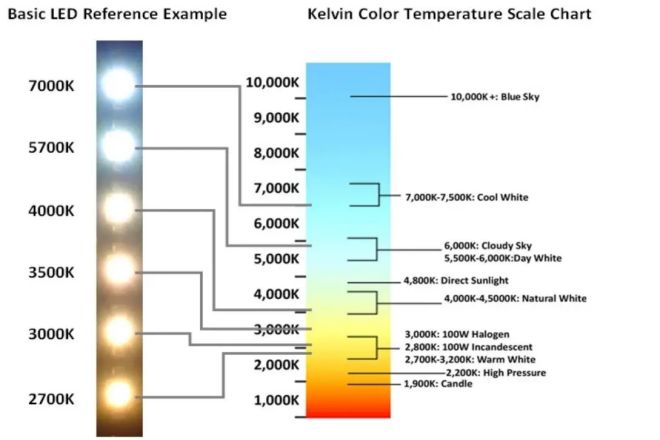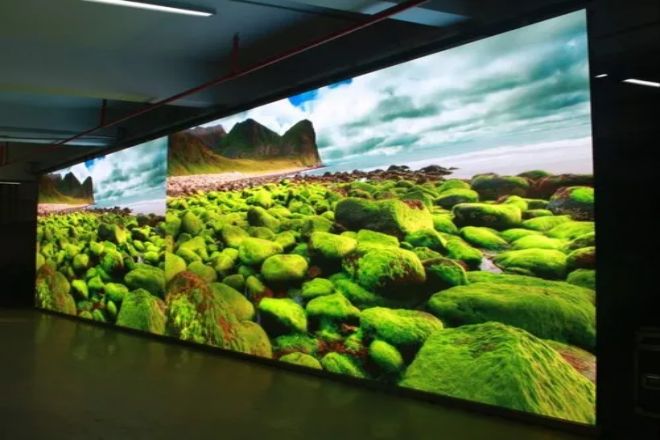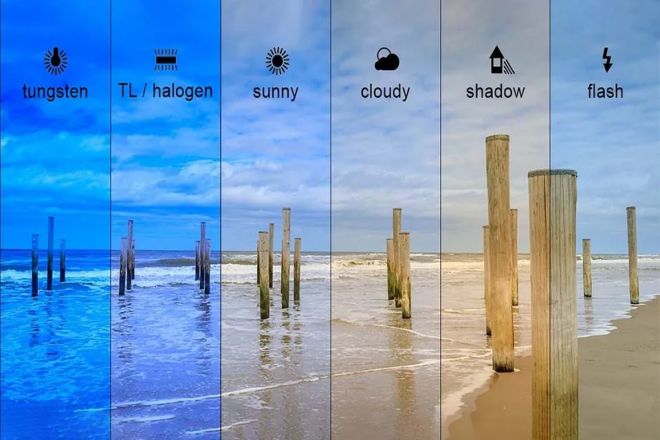مقدمة

الدخول إلى عالم الألوان يعرض الصمامهل سبق لك أن انجذبت بشدة للألوان المتغيرة باستمرار؟ لكن وراء هذه الأضواء الساطعة، يكمن عنصرٌ غالبًا ما يُغفل عنه، وهو درجة حرارة اللون، التي تؤثر بهدوء على متعتك البصرية.
درجة حرارة اللون ليست مجرد مجموعة من الأرقام؛ بل هي ناقل للعواطف، ومنشئ للأجواء، وسلاح للتعبير الإبداعي.
ستأخذك هذه المقالة إلى جوهر درجة حرارة اللون لشاشة LED وتكشف سر هذا السحر البصري.
لا حاجة لنظريات معقدة، فقط اتبع خطواتنا، وسوف تتقن بسهولة تأثير درجة حرارة اللون على تأثير عرض شاشة LED، وفهم كيفية ضبط درجة حرارة اللون بمرونة وفقًا لمتطلبات المشهد المختلفة، بحيث يبرز عملك وسيكون الجمهور مشرقًا.
1. المفهوم الأساسي لدرجة حرارة اللون لشاشة LED

درجة حرارة اللون كمية فيزيائية تصف لون الضوء المنبعث من مصدر ضوء، ولون الضوء المنبعث من جسم أسود عند درجة حرارة معينة. وحدتها كلفن (K).
التعريف العلمي لدرجة حرارة اللون مستوحى من نظرية إشعاع الجسم الأسود في الفيزياء. تحديدًا، إذا سُخّن جسم أسود قياسي ذو قدرة امتصاص وإشعاع كاملة، فمع ارتفاع درجة حرارته تدريجيًا، سيتغير لون الضوء المنبعث من سطح الجسم الأسود من الأحمر الداكن إلى الأحمر الفاتح، ثم البرتقالي المصفر، فالأبيض، وأخيرًا الأزرق.
إذا كان لون الضوء المنبعث من مصدر ضوء معين هو نفس لون إشعاع الجسم الأسود عند درجة حرارة معينة، فإن درجة حرارة الجسم الأسود تسمى درجة حرارة لون مصدر الضوء.
1) العلاقة بين درجة حرارة اللون واللون
تؤثر درجة حرارة اللون بشكل مباشر على لون الضوء المنبعث من مصدر الضوء. بناءً على درجة حرارة اللون، يتغير لون مصدر الضوء بشكل ملحوظ:
درجة حرارة لون منخفضة (أقل من 3300 كلفن): يُصدر مصدر الضوء ضوءًا أصفر دافئًا، مما يمنح شعورًا بالدفء والراحة والاسترخاء. تُستخدم درجة حرارة اللون هذه عادةً في الأماكن التي تتطلب أجواءً مريحة، مثل المنازل والمطاعم وغيرها.
درجة حرارة لون متوسطة (بين 3300 و5300 كلفن): الضوء المنبعث من مصدر الضوء هو أبيض طبيعي أو أبيض محايد، بألوان ناعمة ومريحة، قريبة من لون ضوء الشمس. تُستخدم درجة حرارة اللون هذه على نطاق واسع في المكاتب والمساحات التجارية وغيرها من الأماكن التي تتطلب إضاءة طبيعية.
درجة حرارة لون عالية (أعلى من 5300 كلفن): ينبعث من مصدر الضوء لون أزرق بارد، قريب من لون ضوء الشمس في منتصف النهار، مما يمنح المستخدم شعورًا بالإشراق والانتعاش. تُستخدم درجة حرارة اللون العالية غالبًا في الأماكن التي تتطلب كفاءة في العمل أو شاشات عالية الدقة، مثل المكاتب وغرف العمليات في المستشفيات، وما إلى ذلك.
2) خصائص درجة حرارة اللون لشاشات العرض LED
تتمتع شاشات العرض LED بمرونة عالية ومزايا كبيرة في ضبط درجة حرارة اللون:
- نطاق واسع لضبط درجة حرارة اللون:
يتراوح نطاق درجة حرارة اللون القابلة للتعديل لشاشات عرض LED عادةً بين 3500 و9000 كلفن، مما يُلبي احتياجات الإضاءة المختلفة، من الأصفر الدافئ إلى الأزرق البارد. يُمكّن هذا النطاق الواسع من التعديل شاشات عرض LED من التكيف مع مجموعة متنوعة من سيناريوهات التطبيقات والاحتياجات البصرية المختلفة.
- التحكم الدقيق في درجة حرارة اللون:
تتطور تكنولوجيا شاشات LED الحديثة باستمرار، مما يزيد من دقة التحكم في درجة حرارة اللون. بفضل تقنية ضبط درجة حرارة اللون المتقدمة، يمكن لشاشات LED التحكم بدقة في درجة حرارة اللون، مما يضمن أفضل تأثير للصورة في مختلف البيئات.
- تحسين تجربة المشاهدة:
في دور السينما والمتاحف والمكاتب وغيرها، تُضفي شاشات العرض LED جوًا وشعورًا مُتناغمًا مع المشهد من خلال ضبط درجة حرارة اللون بدقة. هذا لا يُحسّن تجربة المشاهد فحسب، بل يُعزز أيضًا نقل المعلومات.
- الكفاءة العالية وتوفير الطاقة:
تتميز شاشات عرض LED بكفاءة إضاءة عالية واستهلاك منخفض للطاقة أثناء ضبط درجة حرارة اللون. ويعود ذلك إلى خصائص توفير الطاقة لمصدر ضوء LED نفسه وتقنية تبديد الحرارة المتقدمة، مما يُمكّنها من الحفاظ على أداء مستقر طوال فترة التشغيل.
2. ما هي العوامل التي تؤثر على درجة حرارة اللون لشاشات العرض LED؟
1) أنواع رقائق LED
توجد أنواع مختلفة من حبيبات المصابيح الصغيرة (نسميها رقائق LED) على شاشات عرض LED، والتي تُصدر ضوءًا بألوان مختلفة. على سبيل المثال، تعمل بعض رقائق LED برقائق الضوء الأزرق بالإضافة إلى مادة تُحوّل الضوء إلى اللون الأصفر (تُسمى الفوسفور).
بتعديل كمية الفوسفور، يمكن زيادة أو خفض درجة حرارة الضوء. بعض شرائح LED تُضيء مباشرةً باللون الأحمر والأخضر والأزرق. بالتحكم في سطوع هذه الألوان الثلاثة، يُمكن مزج أي لون نريده، بما في ذلك الضوء الأبيض بدرجات حرارة لونية مختلفة.
2) التكنولوجيا الحالية والتحكم
عند تشغيل رقاقة LED، يؤثر شدة التيار على سطوع ولون الضوء. إذا كان التيار غير مستقر، سيتغير لون الضوء المنبعث من LED، وستكون درجة حرارة اللون غير مستقرة.
لذلك، نحتاج إلى استخدام تقنيات متطورة للتحكم في التيار والحفاظ عليه مستقرًا لضمان ثبات درجة حرارة لون شاشة LED. يشبه هذا ضبط تدفق مياه الصنبور، إذ يجب ضبطه إلى الحجم المناسب تمامًا لمنع تناثر الماء.
3) درجة الحرارة المحيطة
ستسخن شاشة LED أثناء العمل، تمامًا كما نشعر بسخونة الجزء الخلفي من الهاتف بعد اللعب به لفترة طويلة. إذا كانت درجة الحرارة المحيطة مرتفعة جدًا، أو لم تُبدد الشاشة الحرارة جيدًا، فلن تعمل شريحة LED بشكل صحيح لأنها ساخنة جدًا، مما يتسبب في تغيير لون الضوء المنبعث، وستكون درجة حرارة اللون غير صحيحة.
لذلك، نحتاج إلى تثبيت جهاز تبديد الحرارة على الشاشة، مثل مروحة صغيرة أو مشتت حراري، لمساعدتها على التبريد والحفاظ على عملها بشكل طبيعي.
4) استخدم الوقت والشيخوخة
أي شيء سيتعرض للتلف تدريجيًا بعد الاستخدام طويل الأمد، وشاشات LED ليست استثناءً. فبعد الاستخدام طويل الأمد، تتآكل رقاقة LED والمواد الداخلية تدريجيًا، تمامًا كما تتآكل أحذيتنا بعد ارتدائها لفترة طويلة. سيؤدي ذلك إلى خفوت الضوء المنبعث من LED، وتغير اللون، بما في ذلك درجة حرارته.
على الرغم من أن هذا أمر لا مفر منه، إلا أنه يمكننا تأخير عملية الشيخوخة هذه عن طريق اختيار رقائق LED ذات الجودة الجيدة والاستخدام والصيانة المعقولة حتى تظل الشاشة في حالة جيدة لفترة أطول.
3. كيفية ضبط درجة حرارة اللون لشاشة LED

يمكن إجراء طريقة ضبط درجة حرارة لون شاشة العرض LED بشكل أساسي من ثلاثة جوانب: التحكم في البرنامج، وضبط الأجهزة، والربط الذكي:
1) التحكم في البرمجيات
- وضع درجة حرارة اللون المحددة مسبقًا:
تم تجهيز معظم شاشات العرض LED الحديثة ببرنامج نظام التحكم، والذي من خلاله يمكن للمستخدمين ضبط درجة حرارة اللون مباشرة.
يوفر برنامج نظام التحكم عادةً مجموعة متنوعة من أوضاع درجة حرارة اللون المحددة مسبقًا، مثل الأبيض الدافئ والأبيض الطبيعي والأبيض البارد وما إلى ذلك. يمكن للمستخدمين اختيار وضع درجة حرارة اللون المناسب وفقًا لاحتياجاتهم.
- إعداد درجة حرارة اللون المخصصة:
بالإضافة إلى الوضع المحدد مسبقًا، تسمح بعض أنظمة التحكم المتقدمة للمستخدمين أيضًا بتعيين درجة حرارة اللون المخصصة.
يمكن للمستخدمين ضبط قيمة درجة حرارة اللون المطلوبة بدقة عن طريق ضبط نسبة سطوع قنوات الألوان الثلاثة الأحمر والأخضر والأزرق.
تتطلب هذه الطريقة من المستخدمين أن يكون لديهم معرفة معينة بالألوان وخبرة في التعديل، ولكنها يمكن أن تحقق تأثير درجة حرارة اللون أكثر تخصيصًا.
2) ضبط الأجهزة
- استبدال أو تعديل حبات مصباح LED:
إذا كانت درجة حرارة لون شاشة العرض LED مختلفة تمامًا عن الطلب، ولا يمكن تحقيق تأثير مرضي من خلال التحكم في البرنامج، فيمكنك التفكير في استبدال أو تعديل حبات مصباح LED.
باستبدال خرزات المصابيح بدرجات حرارة لونية مختلفة، أو تعديل نسبة وترتيب خرزات المصابيح الحالية، يمكن تحقيق تغيير ملحوظ في درجة حرارة اللون. مع ذلك، تُعد هذه الطريقة معقدة ومكلفة نسبيًا، وعادةً ما تكون مناسبة للتطبيقات الاحترافية ذات المتطلبات الصارمة لدرجة حرارة اللون.
- ضبط معلمات الدائرة:
تؤثر معلمات الدائرة أيضًا على درجة حرارة لون شاشات LED. بتعديل التيار والجهد وغيرهما من معلمات دائرة التشغيل، يمكن تغيير شدة الإضاءة والتوزيع الطيفي لخرزات مصابيح LED، مما يؤثر بشكل غير مباشر على درجة حرارة اللون.
ومع ذلك، تتطلب هذه الطريقة معرفة احترافية بالدوائر وخبرة في تصحيح الأخطاء، وقد يؤدي التشغيل غير السليم إلى إتلاف الشاشة أو تدهور الأداء.
3) الارتباط الذكي
- تقنية الاستشعار الذكية جنبًا إلى جنب مع ضبط درجة حرارة اللون:
مع التطور المستمر للتكنولوجيا الذكية، بدأت شاشات LED بدمج وظائف الاستشعار الذكي بشكل متزايد. تتميز هذه الشاشات بقدرتها على ضبط درجة حرارة اللون تلقائيًا وفقًا لتغيرات الإضاءة المحيطة، مما يوفر تجربة بصرية أكثر راحةً وراحة.
على سبيل المثال، في بيئة مظلمة، سوف تتكيف الشاشة تلقائيًا مع درجة حرارة لون أقل (نغمة دافئة) لتقليل التعب البصري؛ وفي بيئة مشرقة، سوف تتكيف مع درجة حرارة لون أعلى (نغمة باردة) لتحسين تأثير العرض والوضوح.
- سيناريوهات التطبيق:
تُستخدم تقنية الربط الذكي على نطاق واسع في العديد من المجالات، كالمنازل والمكاتب والشركات. على سبيل المثال، في أنظمة المنازل الذكية، يمكن لمعدات إضاءة LED ضبط درجة حرارة اللون تلقائيًا وفقًا لإضاءة الغرفة وتفضيلات المستخدم.
في المكاتب وقاعات المؤتمرات، يمكن لشاشات LED الذكية ضبط درجة حرارة اللون تلقائيًا وفقًا لاحتياجات الاجتماع والتغيرات البيئية لخلق جو أكثر احترافية وراحة.
4. تطبيق درجة حرارة لون شاشة LED في سيناريوهات مختلفة

تتنوع تطبيقات درجة حرارة لون شاشات LED في مختلف السيناريوهات. فيما يلي تحليل مفصل لتطبيق كل سيناريو:
1) الإعلان التجاري
في الإعلانات التجارية، يعد اختيار درجة حرارة اللون أمرًا بالغ الأهمية لنقل المشاعر والأجواء المحددة.
- الإعلان عن المنزل الدافئ:
ومن أجل خلق الدفء والراحة في المنزل، تستخدم هذه الإعلانات غالبًا شاشات LED ذات درجة حرارة لون منخفضة (مثل حوالي 3000 كلفن).
يمكن للألوان الصفراء الدافئة المنبعثة من درجة حرارة اللون المنخفضة أن تلهم رغبة الجمهور في المنزل والمشاعر الدافئة، وتعزز جاذبية الإعلان.
- الإعلان عن المنتجات التكنولوجية:
في المقابل، تُفضّل إعلانات المنتجات التقنية استخدام شاشات LED ذات درجات حرارة ألوان عالية (مثل 6000 كلفن). فالدرجات البيضاء الباردة الناتجة عن درجات حرارة الألوان العالية تعكس حداثة المنتجات التقنية واحترافيتها وكفاءتها، وهو ما يتوافق مع خصائصها التقنية.
2). منصة العروض
في تصميم إضاءة المسرح، يعد التطبيق المرن لدرجة حرارة لون شاشة LED أمرًا ضروريًا لخلق تأثير بصري.
- تنسيق تغيير المشهد:
مع تطور أحداث المسرحية، يمكن تعديل درجة حرارة لون شاشة LED آنيًا لتتناسب مع تغيرات المشهد. على سبيل المثال، عند أداء مشاهد رومانسية، يمكن خفض درجة حرارة اللون لخلق جو دافئ ورومانسي، بينما في المشاهد المثيرة، يمكن زيادتها لزيادة توتر الجمهور.
- التأثيرات البصرية:
من خلال التبديل السريع لدرجة حرارة اللون، يمكن لشاشات LED أيضًا إنشاء تأثيرات بصرية فريدة، مثل تدرجات الألوان، والوميض، وما إلى ذلك، لتقديم تجربة بصرية أكثر إثارة للصدمة للجمهور.
3). الملاعب
في الأحداث الرياضية واسعة النطاق، فإن اختيار درجة حرارة لون شاشة LED له تأثير مهم على تجربة المشاهدة للجمهور.
- تعزيز أجواء المشاهدة:
اعتمادًا على طبيعة الحدث، يمكن لشاشة LED ضبط درجة حرارة اللون لإنشاء جو مشاهدة مختلف.
على سبيل المثال، في مباريات كرة السلة، يمكن لدرجات حرارة الألوان الأعلى أن تخلق بيئة لعب مشرقة وواضحة، مما يجعل من الأسهل على الجمهور رؤية تحركات اللاعبين وتفاصيل اللعبة؛ بينما في مباريات كرة القدم، يمكن لدرجات حرارة الألوان المنخفضة أن تخلق جو مشاهدة أكثر دفئًا وعاطفة.
- تعزيز مشاعر الجمهور:
من خلال ضبط درجة حرارة اللون، يمكن لشاشات العرض LED أيضًا تعزيز التجربة العاطفية للجمهور إلى حد ما.
على سبيل المثال، في اللحظات الحرجة أو اللحظات المثيرة، يمكن زيادة درجة حرارة اللون لتعزيز سطوع الصورة وتباينها، مما يؤدي إلى تحفيز حماس الجمهور وشعوره بالمشاركة.
4) إضاءة الأماكن العامة والمناظر الليلية
باعتبارها أحد عناصر إضاءة المشهد الليلي الحضري، فإن اختيار درجة حرارة لون شاشة العرض LED أمر بالغ الأهمية أيضًا لدمج النمط الحضري والأجواء الثقافية.
- تكامل الطراز الحضري:
تتميز كل مدينة بطابعها الحضري وأجواءها الثقافية الفريدة. لذا، ينبغي أن يتناسق اختيار درجة حرارة ألوان شاشات العرض LED مع الطابع الحضري لإبراز سحر المدينة الفريد.
على سبيل المثال، في المدن التاريخية والثقافية، يمكن استخدام شاشات العرض LED ذات درجات حرارة الألوان المنخفضة لخلق جو بسيط وأنيق، بينما في المدن الكبرى الحديثة، يمكن استخدام شاشات العرض LED ذات درجات حرارة الألوان الأعلى لإظهار حداثة المدينة وحيويتها.
- خلق أجواء ثقافية:
في الأماكن العامة، يمكن أيضًا تعديل اختيار درجة حرارة اللون لشاشات العرض LED وفقًا للمناسبات المحددة والأجواء الثقافية.
على سبيل المثال، في المهرجانات والأنشطة الأخرى، يمكن تعديل درجة حرارة اللون لخلق جو مبهج ودافئ، بينما في المناسبات التذكارية والمناسبات الأخرى، يمكن استخدام درجة حرارة لون أقل لخلق جو مهيب ورسمي.
خاتمة
باختصار، تُعدّ درجة حرارة اللون في شاشات عرض LED جزءًا أساسيًا من العرض المرئي، وأهميتها واضحة. فمن خلال التحكم الدقيق في درجة حرارة اللون، لا يمكننا فقط خلق تأثيرات بصرية أكثر حيوية وواقعية، بل أيضًا خلق أجواء فريدة وتعبيرات عاطفية تناسب مختلف المشاهد.
مع التقدم المستمر للتكنولوجيا والتوسع المستمر للسوق، فإن تعديل وتطبيق درجة حرارة اللون لشاشات العرض LED سوف يصبح أكثر ذكاءً وإنسانية، مما يوفر لنا وليمة بصرية أكثر تنوعًا.
وأخيرًا، إذا كنت تريد معرفة المزيد عن شاشات العرض LED، يرجى الحصول على اتصال معنا.
